“Metal Overmolding emerged as a useful and cost-effective process. From automotive to aerospace, this process revolutionizes manufacturing, offering exceptional strength, intricate designs, and streamlined production.”
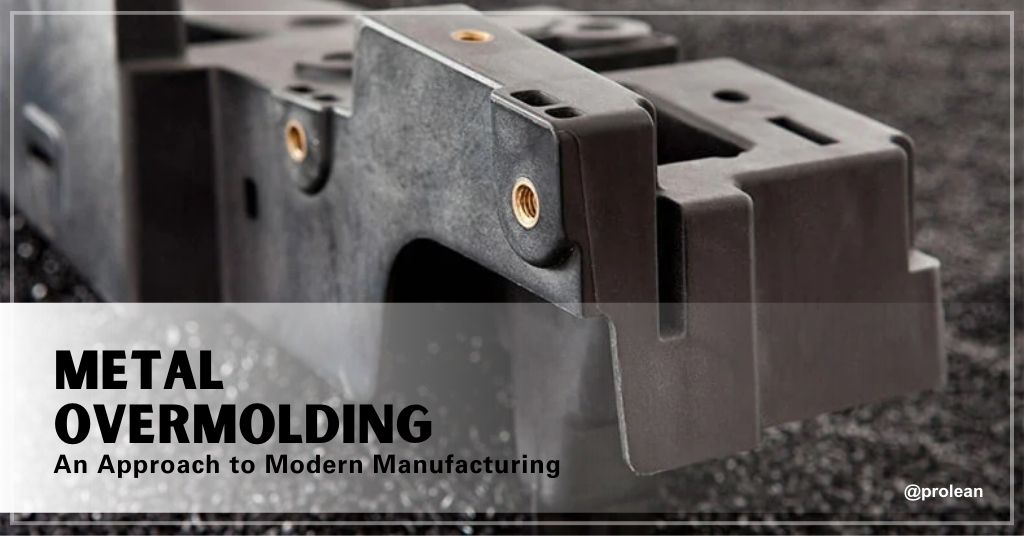
Metal overmolding stands as a transformative process, known for its precision and effectiveness in designing complex metal shapes. It has gained considerable attention from industries due to its versatile benefits. The products formed through this technique offer incomparable mechanical strength and superior functionality. Unlike traditional metal cutting techniques, which often result in tool wear and breakage, metal overmolding comes with a solution in terms of high strength, durability, and conformity in products with minimal turnaround time.
Through this article, you will be able to understand the complexities around metal overmolding, its types, applications, how to choose metal substrates, and overmolding materials and so more.
What is Metal Overmolding?
Metal overmolding is the type of injection molding process that involves encapsulating metal components within the molten metal to create integrated parts. It combines the strength, rigidity, and conductivity of metal with the versatility, design freedom, and cost-effectiveness of plastics.
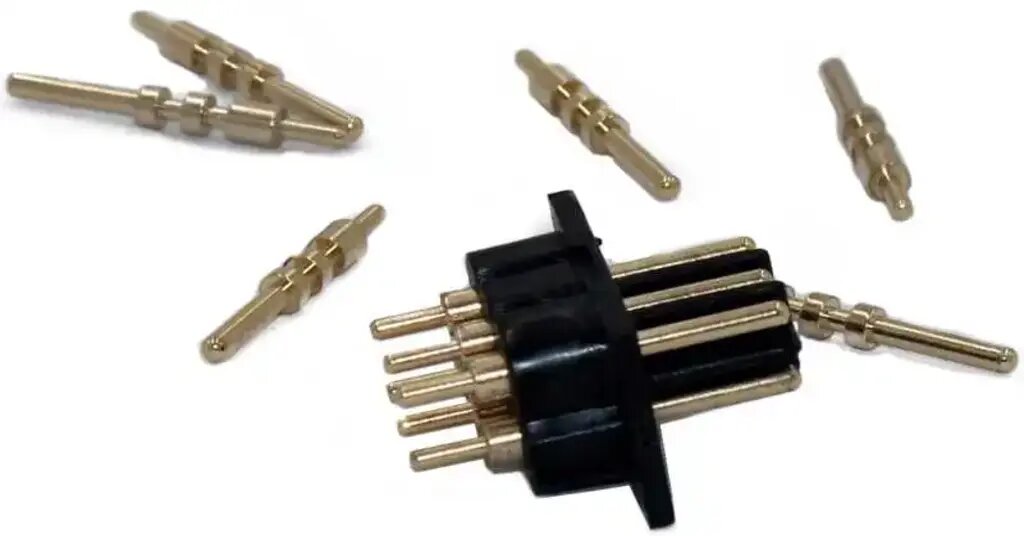
Metal Overmolding
Moreover, It offers various advantages, including enhanced product functionality, improved aesthetics, increased durability, and reduced weight.
Try Prolean Now!
What Steps Are Involved in the Metal Overmolding Process?
There are a few steps involved in the overmolding process.
1. Designing the metal substrate
The process begins with designing the metal insert or substrate that will serve as the base component for over-molding. This is the core part of the metal overmolding process as it determines the actual dimensions.
2. Fabricating the Metal Insert
Once the design is finalized, the metal insert is fabricated using traditional metal forming techniques such as die-casting, machining, or metal injection molding. The insert is carefully crafted to meet the specifications of the final product.
3. Preparing the Injection Mold
A mold is prepared for the overmolding process. This mold consists of two halves: a stationary half and a moving half. The metal insert is placed into the mold cavity in the stationary half.
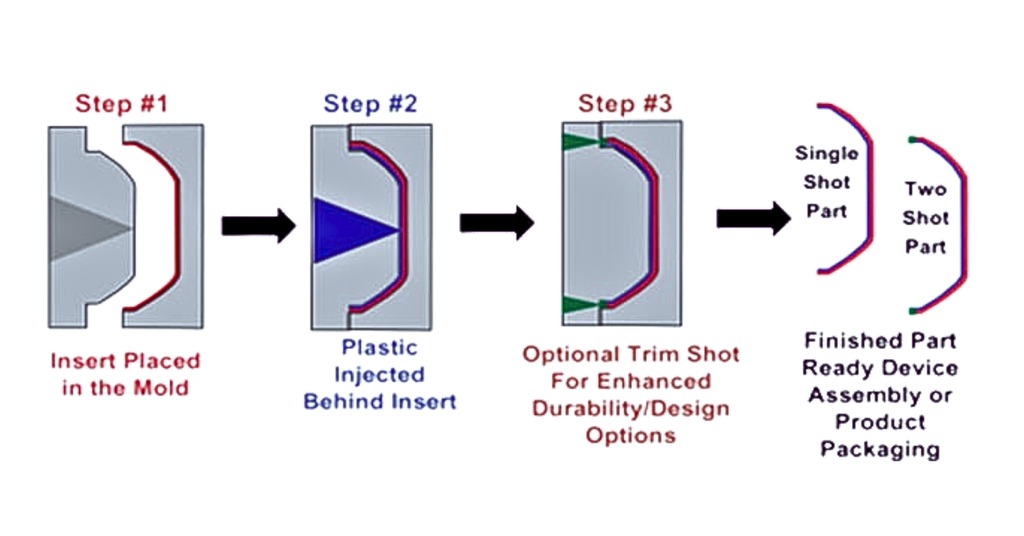
Making of Complex Part Through Overmolding Process
4. Injection Molding
Molten plastic material is then injected into the mold cavity around the metal insert. This plastic material is typically a thermoplastic polymer that is heated to a molten state and then injected under high pressure into the mold cavity.
5. Cooling and Solidification
Once the plastic material has been injected, the mold is cooled to allow the plastic to solidify around the metal insert. The cooling time may vary depending on the type of plastic material used and the thickness of the over-molded part.
6. Ejection and Finishing
After the plastic has solidified, the mold is opened, and the newly formed over-molded part is ejected from the mold. The part may undergo additional finishing processes such as trimming, deburring, or surface treatment to achieve the desired final appearance and dimensions.
Overmolding Vs. Insert Molding: Are They Same?
Overmolding and insert molding, both terms are used interchangeably. Despite having some similarities, these are often misunderstood as the same. Let’s figure out their distinguished factors;
Overmolding
Overmolding is an injection molding or compression molding process where a metal substrate is molded with a plastic material to create a composite part. It employs different metals like aluminum, titanium, stainless steel, and brass, as the base (Substrate) materials.
Overmolding is done for the sole objective of creating durable, aesthetic, and functionally enhanced parts. It is usually done with materials, such as polymers, metals, or elastomers. It is considered as an invaluable technique as it serves the purpose of insulation for the product.
Metal Insert molding
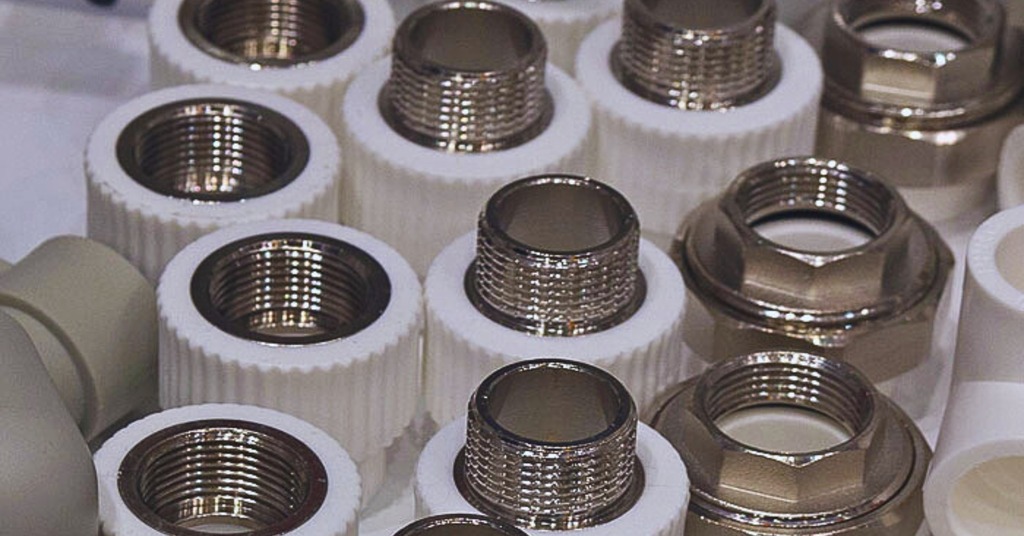
Metal Insert molding
On the other hand, insert molding, uses a pre-formed or pre-fabricated component, into the mold cavity before plastic material is injected. The plastic material then surrounds and bonds to the insert, creating a single integrated part.
It is widely used to encapsulate inserts such as metal pins, screws, wires, or other components within a plastic.
Similarities between Overmolding and Insert Molding
Despite having some differences in their processes, there are some similarities between the two; Let’s evaluate their likenesses;
- Overmolding and Insert molding, both are types of multi-material injection molding.
- Both overmolding and insert molding involve the integration of multiple materials to create a single, cohesive part.
- Overmolding and insert molding are used for producing functional prototypes and bridge tooling.
- The core purpose of both processes is to enhance the functionality and aesthetics of the desired product.
- They offer designers and engineers greater flexibility in surface finishes, material selection, and color options.
Dissimilarities between Overmolding and Insert Molding
However, there exist several dissimilarities that can alter the choice of manufacturers in selecting the suitable process according to their requirements.
- Overmolding is about molding the pre-existing substrate with the secondary material on it. Meanwhile, insert molding molds the substrate material around pre-inserted components.
- Overmolding does tend to be more complex compared to insert molding, primarily due to the interaction between the different materials involved, insert molding typically focuses on molding the substrate material around the insert, which can be relatively straightforward in comparison.
- Overmolding offers greater design and multi-material options whereas, insert molding has somewhat limited design options.
- Overmolding requires molds with features for bonding multiple materials whereas, insert molding focuses on proper insert alignments and accommodation within the substrate.
Metal Substrates Used in Overmolding
Stainless steel
Stainless steel serves as a durable metal substrate for overmolding applications.
- Being corrosion-resistant is the core attribute that makes it suitable for use in harsh, acidic environments.
- Its compatibility with different plastic materials enables designers to craft more complex or sophisticated designs.
- Because of its toughness, it has a vast application in the making of surgical instruments, kitchen appliances, engine parts, etc.
Titanium
Titanium substrates are relatively rare and costly when compared to other metals due to their limited production and supply-chain challenges.
- Titanium is well known for its high strength-weight ratio which means that it is one of the lightest hence strongest metals in the world.
- Additionally, titanium is non-toxic and biocompatible which makes it suitable for aerospace engineering applications.
- Titanium widely serves in military and defense applications for making missiles, aircraft, and many others.
Aluminum
Aluminum can be used as a substrate for several reasons;
- Aluminum is known for its good thermal conductivity and excellent machinability.
- Aluminum is also a good conductor of electricity, making it suitable for applications where electrical conductivity is required. For instance, in electronic devices, aluminum substrates can provide grounding or shielding capabilities.
- Substrates of aluminum can undergo various surface treatments or coatings to improve adhesion with the over-molded materials.
- Hence, it has applications across the automotive industry, for instance, aircraft frames, fuselage sections, and wing structures.
By combining these metals, product designers or prototype designers can achieve synergistic benefits such as enhanced strength, improved aesthetics, and corrosion resistance.
Click here to download: The List of Overmolding Metals and Alloys
Try Prolean Now!
Technical Aspects of Metal Overmolding Process
The Parameter ranges provided below may vary from process to application.
Table: Technical aspects of metal overmolding
| Parameters | Typical range |
| Injection Pressure | 10,000 – 30,000. psi (690 – 2068 bar) Source. |
| Injection Speed | 2 – 20 inches per second (50 – 500 mm/s) |
| Injection Temperature | 150°C – 300°C (302°F – 572°F) |
| Debinding Temperature | 400°C – 600°C (752°F – 1112°F) |
| Sintering Temperature | 1200°C – 1400°C (2192°F – 2552°F) |
| The density of Sintered Parts | 6.5 – 7.5 g/cm³ (0.235 – 0.271 lb/in³) |
| Mechanical Properties | Tensile strength: 500 – 800 MPa, |
| Yield strength: 400 – 600 MPa | |
| Elongation: 2% – 10% | |
| Hardness: 50 – 70 HRC | |
| Surface Roughness | 10 – 50 microinches (0.25 – 1.25 micrometers) |
| Dimensional Accuracy | ±0.001 – ±0.005 inches (25 – 127 micrometers) |
| Production Rate | 100 – 1000 parts per hour (PPH) |
Advantages of Metal Overmolding
Compared to the traditional method of molding metals into desired geometrical shapes, there are several advantages of modern metal overmolding.
- Metal overmolding has made it easier to fabricate complex geometrical shapes that were once a big challenge to handle.
- It is a cost-effective solution as it’s not a labor-intensive process.
- It allows numerous types of metals to be used like stainless steel, titanium, aluminum, and various alloys which ultimately benefits manufacturers.
- The metal molding allows for the exact specification of the desired shape maintaining consistency across production batches.
- It has reduced the time for production cycles which allows manufacturers to respond more quickly to changing market demands.
Disadvantages of Metal Overmolding
While metal overmolding has numerous advantages, it also has some disadvantages which are discussed below:
- It often involves complex tooling requirements. And may become challenging to achieve tight tolerance and proper adhesion which can further impart quality issues.
- High temperature and pressure requirements can encounter several safety hazards for the people working there and hence require strong control measures.
- Metal overmolding requires high energy consumption and large amounts of waste including metal scraps and chemical residue which can negatively impact the ecosystem.
Despite these disadvantages, metal overmolding is still the most preferable and effective choice for producing sophisticated designs.
Industrial Applications of Metal Overmolding
Metal Overmolding offers plenty of benefits, from embedded electronics to making everyday tools easier to grip and friendly to use. Let’s discuss the industrial applications of Metal Overmolding;
Metal Overmolding in the Automotive Industry
In the automotive sector, this technology finds extensive use in producing engine components such as cylinder heads and pistons. By overmolding metal substrates with specialized materials, manufacturers achieve components that withstand the rigors of engine operation while improving efficiency and longevity.
Additionally, metal overmolding plays a crucial role in suspension systems, where it reduces vibration and enhances ride comfort, contributing to overall vehicle performance. Moreover, in interior trim applications, such as door handles and dashboard panels, metal overmolding ensures both aesthetic appeal and durability, meeting the demanding requirements of modern automotive design.
Metal Overmolding in the Electronics Industry
In the electronics industry, metal overmolding is employed to create connectors, terminals, and housings for electronic devices. By combining metal frames with over-molded plastics, manufacturers achieve secure connections, environmental protection, and durability, essential for the reliability of electronic components.
Furthermore, metal overmolding facilitates heat dissipation solutions, such as heat sinks, which help manage thermal loads in electronic systems, ensuring optimal performance and reliability, particularly in high-power applications.
Metal Overmolding in the Medical Industry
In medical equipment manufacturing, metal overmolding plays a critical role in producing surgical instruments, implantable devices, and diagnostic equipment. Surgical instruments benefit from ergonomic grips and stabilizability provided by metal overmolding. Moreover, Implantable devices leverage biocompatible materials over-molded onto metal substrates to enhance tissue integration and patient comfort.
Additionally, diagnostic equipment components benefit from the durability and resistance to harsh chemicals offered by metal overmolding, ensuring the accuracy and reliability of medical diagnostics.
Metal Overmolding in the Aerospace and Defense Industry
In aerospace and defense applications, metal overmolding contributes to lightweight yet durable solutions for aircraft components, military equipment, and avionics systems. Aircraft components, such as structural brackets and aerospace connectors, benefit from the combination of metals with over-molded materials, providing strength, corrosion resistance, and reliability in demanding aerospace environments.
Similarly, military equipment, including firearms and protective gear, utilizes metal over-molding to enhance ruggedness and operational performance in harsh conditions.
Read more:
- CNC Boring Material: A Comprehensive Guide to Making the Right Choice
- Pros and Cons of EDM: A Balance Perspective
Try Prolean Now!
Overmolding Services at Prolean
At Prolean, we offer high-quality custom overmolding services for your simple to complex prototyping needs. Our services range across various industries from automotive, and aerospace to robotics.
Our priority of getting work done on time and within the budget increases the customer’s confidence in our abilities. Get reliability and quality assurance with our ISO 9001 2015 standards as we have earned a reputation for delivering the highest quality services. So, send us your project and get a free quote today!
Summing Up
Metal overmolding offers dozens of benefits in both simple and complex shape prototypes. It’s not only providing an effective way to precisely do the job of metal reshaping but also addressing the evolving needs of various industries. Despite its certain disadvantages, it is still demanding and the most preferred choice among product designers.
However, selecting the right material for substrate and overmolding might be confusing in several ways. So, it’s best to consult with experts for a smooth and streamlined production according to your needs.
FAQ’s
Q1- How does the cost of metal overmolding compare to other manufacturing methods?
The cost of metal overmolding may vary depending on various factors such as material selection, part complexity, tooling requirements, and production volume, but it can be competitive compared to other manufacturing methods.
Q2- How could I Optimize my design for successful overmolding?
Design optimization depends upon certain factors, for instance; selecting compatible materials, designing appropriate part geometry, and ensuring proper placement of inserts. To optimize your design you can seek help from our Overmolding Design Guide, for a successful overmolding.
Q3- What if I want to choose another useful process rather than overmolding?
Yes, you can choose an alternative to overmolding depending on your specific product requirements. Here are some useful processes you can opt for;
- Investment Casting
- Die-Casting
- Sand Casting
Q4- What types of plastic materials are compatible with metal overmolding?
Plastic materials compatible with metal overmolding include thermoplastics such as ABS, polycarbonate, polypropylene, and TPE (thermoplastic elastomer).
Resources
1. A. Schrek & Pavol Svec. (2015). Optimization of Overmolding Process of Metal-Plastic Part. Retrieved From: https://www.researchgate.net/publication/287222780_Optimization_of_Overmolding_Process_of_Metal-Plastic_Part
2. Wiley, online library.(2017) Injection Overmolding of Polymer–Metal Hybrid Structures, Retrieved From: https://onlinelibrary.wiley.com/doi/10.1002/9781119429807.ch10
3. Deepak Kumar Pokkalla. (2023). A novel additive manufacturing compression overmolding process for hybrid metal-polymer composite structures. Retrieved From: https://www.sciencedirect.com/science/article/pii/S2772369023000099
4. Atefeh A. Tafti. 2021. Effect of Thermal Debinding Conditions on the Sintered Density of Low-Pressure Powder Injection Molded Iron Parts. Retrieved From: https://www.mdpi.com/2075-4701/11/2/264

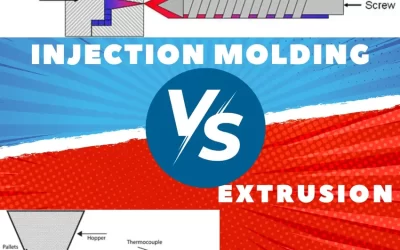
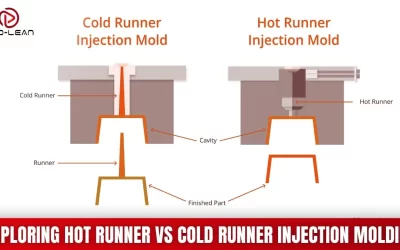
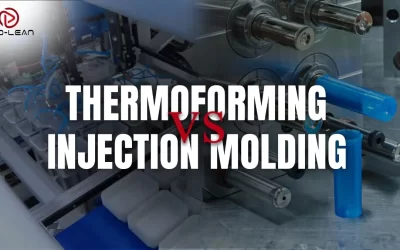
0 Comments